A tour through the Smithsonian's The Art of Video Games exhibit
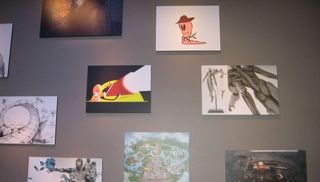
It's an argument that's been beaten to death over the past decade: are video games truly art? The debate might've finally been settled, now that gaming has a place in one of the nation's most distinguished museums. The Smithsonian American Art Museum in Washington D.C. recently unveiled The Art of Video Games exhibit, showcasing 40 years of our favorite pastime's evolution. We decided to drop by, see what all the hubbub was about, and, more importantly, make sure the PC gaming classics made it in.
Nestled in a chamber on the Smithsonian's third floor, the exhibit exudes arcade-like vibes, projecting neon light and chiptunes into an otherwise-silent hallway full of paintings and sculptures. You're first greeted by a statement from the exhibit's primary curator, Chris Melissinos. "The common thread [among games], regardless of intent, is that they are an amalgam of disciplines—storytelling, animation, music, and cinematography—whose sum is greater than its parts," he writes. "This defines a new art medium that is beyond traditional definitions used in the fine art world." Melissinos views gaming as a dialogue between the artist, the player, and the game itself, just as a painter requires a canvas and a viewer to create something that could be called art. "Everyone who plays a game puts a little of themselves into the experiences, and takes away something that is wholly unique," says Melissinos. "This conversation among the game, the artist, and the player is critical to understanding video games as art."
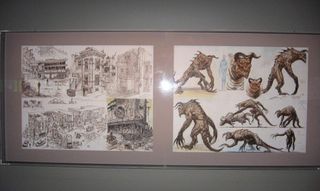
Every visitor is captivated by what they first encounter in the exhibit: a gigantic projection of game clips showcasing action from every era and system. Once you've taken your eyes off this glowing game-filled wall, you wander into a room filled with still art—early level designs, character concepts, and screens displaying interviews with industry personalities like Warren Spector and Tim Schafer, discussing high-level concepts like inspiration and narrative in games. The concept art strewn about the room was quite eye-pleasing (save, perhaps, for a hilariously-outdated sketch of Kerrigan—the Queen of Blades has come a long way since then). Though you'll see quite a bit of Sonic and Solid Snake, it's easy to appreciate the goofy expressions of the invertebrate soldiers from Worms Armageddon, or the hulking monster designs from Fallout 3. Less interesting is a screen showing footage of people's reactions as they play games, which stuck out like a sore, boring thumb in a room full of radical things to look at.
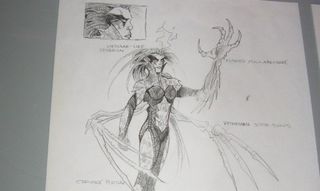
The next area is where things get interactive: five classic games on humongous monitors that visitors can walk up to and play for a spell. PC gamers might yawn at demos of Pac-Man, Super Mario Brothers, and Flower, but they'll feel a nostalgic warmth when they spot games like The Secret of Monkey Island and Myst being enjoyed by those who might've never played a game before in their lives. It was a hoot watching an 70-year-old woman try to navigate the first room of Myst. She was unable to grasp the mechanic of clicking to move around, but was still appreciative of the game's visual ambiance. I had also forgotten how many options Guybrush had at his disposal in the first Monkey Island: commands like Close, Push, and Pull feel like relics of adventure games past.

The third and final room will be the most or least interesting for you, depending on how broad your gaming horizons are. This is where every system from the Atari VCS to the PlayStation 3 is up for display, along with a selection of four games that represent each console—though it's definitely debatable if these really are the games that "best" exemplify the highlights on each system. They fall into four categories: Action, Target (which, frankly, seemed interchangeable with Action), Adventure, and Tactics. The PC gets not one, but two podiums in this room—one for DOS /Windows 95 (which it groups in the "Transition" era with consoles like the Dreamcast and the first PlayStation) and another for Modern Windows (despite the name, this isn't the next entry in the Call of Duty franchise). Each podium comes with its own monitor, so viewers can see the four games in action, while a voiceover explains each game's objective and significance.
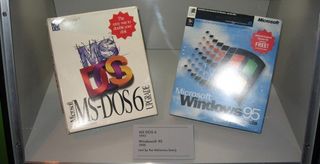
The DOS/Windows lineup was hard to dispute: Doom II, Diablo II, Fallout, and StarCraft all paved the way for hundreds of classic games. Plus, who wouldn't want to gaze into the fiery maw of a Cacodemon while they stroll around an art exhibit? The Modern Windows selections are a bit shakier—Portal for Action, flOw for Target, Fallout 3 for Adventure, and Minecraft for Tactics didn't really seem like the right fits. I wouldn't call Portal an action game more than a spatial puzzler, and flOw brings the PS3 to mind before I think of it on PC. As for Minecraft, it definitely deserved a place on the podium—just not as a tactical game. The videos accompanying each game suffered from some haughty writing—for example, Minecraft's narration included the line "The power of the internet combined with the human need to create makes Minecraft an endlessly evolving celebration of ingenuity and expression." But all in all, they did an excellent job of showing newcomers what each game was about, while sparking fond memories in those who had already played them.
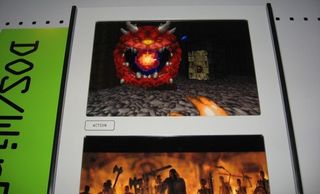
And, surprisingly, that was the entire exhibit. While it's not the kind of show that you should travel cross-country to see in person, it's worth a look if it's in the area, or if you want to introduce the elderly members of your family to the world of gaming you've been enjoying all this time. While it might not be an eye-opening experience to hardcore gamers, it's nice to finally see video games get attention from an institution as prestigious as the Smithsonian. The exhibit will be on display at the Smithsonian until September 30th, at which point it'll begin a tour to 10 cities around the nation. If this show sounds like your kind of art exhibit, you'll find the currently scheduled tour dates below:
The biggest gaming news, reviews and hardware deals
Keep up to date with the most important stories and the best deals, as picked by the PC Gamer team.
- Boca Raton Museum of Art (October 24, 2012–January 20, 2013)
- EMP Museum in Seattle (February 16, 2013–May 13, 2013)
- Phoenix Art Museum (June 16, 2013—September 29, 2013)
- Hudson River Museum in Yonkers, NY (February 15, 2014–May 18, 2014)
- Toledo Museum of Art in Toledo, Ohio (June 19, 2014–September 28, 2014)
- Flint Institute of Arts in Flint, Michigan (October 25, 2014–January 18, 2015)
- Memphis Brooks Museum of Art in Memphis, Tennessee (June 6, 2015–September 13, 2015)
- The Patricia and Phillip Frost Art Museum at Florida International University in Miami, Florida (October 9, 2015–January 25, 2016)
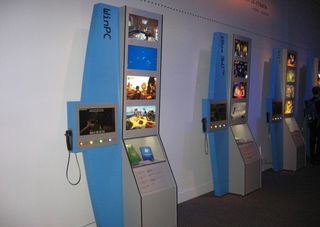
Most Popular





